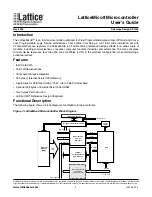
Advisory
ePWM: An ePWM Glitch can Occur if a Trip Remains Active at the End of the
Blanking Window
Revisions Affected
0, A, B
Details
The blanking window is typically used to mask any PWM trip events during transitions
which would be false trips to the system. If an ePWM trip event remains active for less
than three ePWM clocks after the end of the blanking window cycles, there can be an
undesired glitch at the ePWM output.
illustrates the time period which could result in an undesired ePWM output.
Trip Active
Trip Source
Blanking Window
Blanking Window
Active
Undesired Trip
Active-to-Inactive Transition
Trip Inactive
Blanking Complete
3 ePWM cycles
Figure 3-5. Undesired Trip Event and Blanking Window Expiration
illustrates the two potential ePWM outputs possible if the trip event ends within
1 cycle before or 3 cycles after the blanking window closes.
ePWM Output Pin (Possibility A)
(Trip interrupt will be issued)
ePWM Output Pin (Possibility B)
(Trip interrupt will not be issued)
Active
State
Trip
State
Active
State
Trip
State
Active
State
Trip
State
Active State
Figure 3-6. Resulting Undesired ePWM Outputs Possible
Workaround
Extend or reduce the blanking window to avoid any undesired trip action.
Advisory
ePWM: Trip Events Will Not be Filtered by the Blanking Window for the First
3 Cycles After the Start of a Blanking Window
Revisions Affected
0, A, B
Details
The Blanking Window will not blank trip events for the first 3 cycles after the start of a
Blanking Window. DCEVTFILT may continue to reflect changes in the DCxEVTy signals. If
DCEVTFILT is enabled, this may impact subsequent subsystems that are configured (for
example, the Trip Zone submodule, TZ interrupts, ADC SOC, or the PWM output).
Workaround
Start the Blanking Window 3 cycles before blanking is required. If a Blanking Window is
needed at a period boundary, start the Blanking Window 3 cycles before the beginning of
the next period. This works because Blanking Windows persist across period boundaries.
Silicon Revision B Usage Notes and Advisories
24
TMS320F28004x Real-Time MCUs Silicon Errata
Silicon Revisions B, A, 0
SPRZ439G – JANUARY 2017 – REVISED AUGUST 2022
Copyright © 2022 Texas Instruments Incorporated
















































